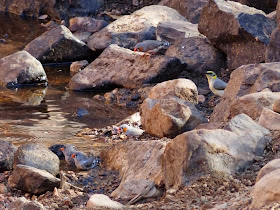Driving the empty bus home recently from our central Australian tour, we stopped off at Warrigal Waterhole near Mount Isa, deep in the tropics in north-western Queensland. 'Warrigal' is a word once widely used - though less so now - for a Dingo, though it has also been applied to Aboriginal people living in a traditional manner, and feral horses. Since the root word was apparently from the language of the long-gone Sydney people (whose name may have been something like Dharuk) the use for the waterhole is either a 'whitefella' application, or a 'sounds like' borrowing from the local Kalkadoon language.
Whatever the origin of the name, it was a delightful spot and an hour flew, despite sitting on granite rocks!
The access road is a four wheel drive track, and we had to abandon our bus early on and do a five kilometre return walk across rapidly warming open country - well it was only about 30 degrees, but warm enough.
 |
| The bus waits patiently; the road was more deeply rutted and gouged than this picture suggests. |
This is arid land, with tumbled gibbers (wind polished rocks tumbled from the eroding hills) and spiky Spinifex Grass (Triodia spp.) dominating. There are many termite mounds (the termites live by harvesting the spinifex), and a scattering of eucalypts and acacias.
 |
| Beautiful country in itself, but we were just passing though... |
When we reached the gorge, there was still a serious obstacle to bypass...
 |
| He could well have been feral, but even 'domestic' cattle here are pretty wild; we cautiously climbed the rocky hillside above him, and were relieved when he ambled off. |
The waterhole itself is a beautiful oasis, cool and shady. Such places in desert lands are crucial for wildlife, and are great (and very pleasant) places to watch it.
 |
| Willie Wagtail Rhipidura leucophrys, a fantail. |
 |
| Grey-fronted Honeyeaters, above and below. See here for a posting on this widespread genus of honeyeaters; when I wrote it however I didn't have any photos of this species! |
In the background of this photo is a young Long-tailed Finch Poephila acuticauda, here at the south-eastern edge of its tropical distribution. I hadn't expected to see them here, and it was one of four finch species which visited while we watched. Another finch gave us perhaps the most pleasure though, as we'd missed it in central Australia, and this was really our last chance for the trip.
 |
| Painted Finch Emblema pictum standing above the Grey-fronted Honeyeaters. |
 |
| Another Painted Finch (or rather the one above again), and top left (blurred by its movement) a Zebra Finch, numerous throughout the Australian arid lands. |
Back to Warrigal Waterhole, where two species of elegant little doves were also much in evidence.
I've sat by many desert waterholes, but I can't remember such a peacefully busy time as we spent watching the birds come to Warrigal Waterhole.
BACK ON FRIDAY











That bull looks very like (colour, shape of horns) the Spanish fighting bulls. I wonder if they have wasted decades developing breeds that occur naturally if left to their own devices.
ReplyDeleteOf course, this confirms your good sense in giving it a wide berth!
Martin
Thanks Ian.
ReplyDeleteFurther on your introductory comment about the name of the waterhole: Yes, warrigal is from the Sydney Language (attested in early records, and analysable as waRi 'distant' -gal 'denizen'), then spread in the 19th century interlanguage called NSW Pidgin. The word occurs in a number of official placenames mostly in the eastern mainland states (data from http://www.ga.gov.au/place-names/ ) which may well have been bestowed by Aboriginal and 'white'people combined, typically as co-workers in the pastoral industry. Of course, individual cases may have had some other kind of origin, but it is unusual these days to discover anything of their 'narrative of bestowal'. I'd be interested if you do learn more on the nice spot you visited.
Martin, that very thought occurred to me - I was especially taken by the black-tipped horns...
ReplyDeleteDavid, thank you so much for that input - I greatly value your expertise in these matters, and your generosity in sharing it. If I hear more of the origins of Warrigal Waterhole's name I'll certainly share it, though I'm not optimistic.